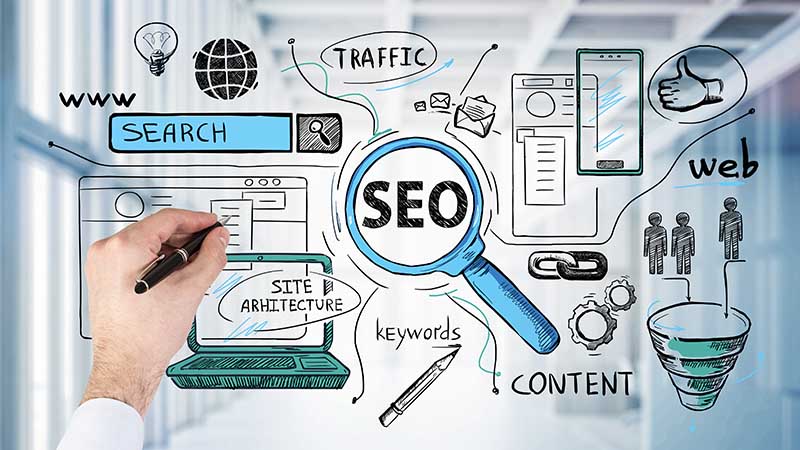November 15, 2023
Optimize Your Website to Attract and Convert Pest Control Leads

In today’s digital age, having a website for your pest control business is no longer an option; it’s a necessity. Not all websites are created equal, and not all digital marketing strategies yield the same results. We understand the unique challenges of the pest control industry, and we specialize in a tailored approach to your site that goes beyond aesthetics and generic tactics.
Join us on a journey where we explore the art of optimizing your website to not only attract but also convert valuable pest control leads. In this blog, we’ll delve into the core principles that will drive sustainable growth for your business.
Discover how user-centric web design and an effective local marketing strategy can transform your online presence and bring in leads to boost your bottom line.
It’s time to rise above the digital marketing noise and stand out in the competitive world of pest control. Welcome to a blog that’s not just about looking good online; it’s about achieving tangible results.
Jump Ahead:
- Visual Website Optimization
- User-Friendly Design
- Guiding Visitors Towards Action
- CRO and A/B Testing
- Website Optimization for Marketing
- SEO and Visibility
- Paid Search and Local Service Ads
- Content Marketing
- Closing
Visual Website Optimization
It’s important to remember your website serves as the virtual storefront for your pest control business. It’s the place where potential clients form their first impressions, gather information, and ultimately decide whether to choose your services. Let’s explore the critical facets of website optimization and why they are paramount in attracting and converting pest control leads.
First Impressions Matter
Imagine a potential client searching for pest control services in their area. They come across your website as the first search result. In that split second, your website becomes the face of your business. This initial impression can make or break a potential client’s decision.
A well-designed and user-friendly website creates a positive impression. It instills confidence and trust in your professionalism and reliability. On the other hand, a dated or confusing website can quickly deter prospects. That’s why your website’s design, layout, and overall user experience matter tremendously.
The Essence of User-Friendly Design
A user-friendly website is your secret weapon for keeping potential clients engaged. Here’s why:
- Easy Navigation: A clear and intuitive navigation structure is like a roadmap for your visitors. It helps them find the information they need effortlessly. Confusing navigation can frustrate users and lead them to exit your site.
- Quick Loading Times: In today’s fast-paced world, nobody likes to wait. A website that loads quickly not only provides a better user experience but also improves your search engine rankings. Google favors fast-loading websites, which can lead to more organic traffic.
- Mobile Responsiveness: Everyone has a smartphone these days – mobile responsiveness is non-negotiable. Your website must adapt seamlessly to various screen sizes and devices. A mobile-friendly site ensures that potential clients can access your services on the go.
Guiding Visitors Towards Action
Design isn’t just about aesthetics; it’s about creating an environment that motivates action. Effective design elements and strategic placement of calls-to-action (CTAs) can significantly impact your conversion rates. Here’s how:
- CTA Placement: CTAs serve as guiding beacons, directing visitors toward the actions you want them to take. Whether it’s encouraging them to request a quote, schedule an inspection, or sign up for newsletters, the placement and visibility of CTAs are paramount.
- Design Elements: Visual elements, such as images, graphics, and color schemes, play a pivotal role in capturing visitors’ attention and conveying your brand’s message. They have the power to evoke emotions and create a lasting impression.
Conversion Rate Optimization
Conversion Rate Optimization (CRO) is the science and art of improving the percentage of website visitors who take a desired action, such as making a purchase, filling out a contact form, or signing up for a newsletter. In the context of your pest control business, CRO is the key to turning website visitors into valuable leads and, ultimately, loyal clients. In this section, we’ll delve into the fundamentals of CRO, the role of A/B testing, and how to optimize conversion funnels on your website.
A/B Testing in Optimizing Conversion Rates
A/B testing, also known as split testing, is a fundamental technique in the world of CRO. It involves creating two or more versions (A and B) of a webpage, each with slight variations in design, content, or functionality. These versions are then presented to website visitors randomly to determine which one performs better in terms of achieving the desired conversion.
A/B testing provides valuable insights into what elements of your website resonate most with your audience. It answers questions like which headline is more compelling, which CTA button color generates more clicks, or which form layout is more user-friendly. By systematically testing and analyzing these variables, you can make informed decisions to optimize your website for maximum conversions.
Identify and Optimize Conversion Funnels on Your Website
Conversion funnels are the paths that users take on your website before completing a specific action, such as submitting a contact form or requesting a quote. Understanding these funnels is crucial for improving the user journey and increasing conversion rates.
To optimize conversion funnels, you must first identify them. Analyze user behavior using tools like Google Analytics to track the steps users take before converting. Once identified, you can pinpoint potential bottlenecks or drop-off points in the funnel and make targeted improvements.
Optimizing conversion funnels involves streamlining the user experience, reducing friction, and providing the right incentives or information at each stage of the journey. By carefully crafting and refining these paths, you can guide visitors seamlessly toward the desired action, effectively boosting your pest control leads.
Website Optimization for Marketing
Now that we’ve explored the intricacies of optimizing your website’s visual appeal and user experience, let’s shift our focus to the digital marketing strategies that will drive an influx of pest control leads. Just as your physical storefront attracts passersby, these digital strategies serve as beckoning signposts in the vast online landscape, guiding potential clients toward your virtual doorstep. From enhancing your website’s visibility with SEO to swiftly generating leads through PPC, and from establishing authority with content marketing to engaging your audience on social media, these strategies form the core of your online success story.
SEO and Visibility
Having a stunning website is great, but it’s of little use if potential clients can’t find it. This is where Search Engine Optimization (SEO) comes into play. SEO is the art and science of making your website visible to search engines like Google.
When your website is optimized for relevant keywords and phrases related to pest control, your local market, and the things your audience is searching for, it stands a higher chance of appearing in search results. This visibility is invaluable in attracting organic traffic—people actively searching for pest control services. SEO is the foundation upon which your online presence is built, and it’s a long-term investment that pays dividends in the form of organic, cost-effective leads.
Paid Search and Local Service Ads
While SEO builds over time, there’s also a place for more immediate results through paid search advertising, including Local Service Ads. Paid search, often referred to as Pay-Per-Click (PPC) advertising, allows you to bid on keywords and have your website appear at the top of search results for those terms.
The benefit of paid search, including Local Service Ads, is that it can deliver leads quickly and prominently feature your services to potential clients in your local area; however, it’s essential to strike a balance between paid and organic strategies. Paid search can be costly, and when the budget is exhausted, the leads can dry up. A well-thought-out PPC campaign, along with Local Service Ads, complements your SEO efforts, providing a steady stream of leads while your organic visibility grows.
Content Marketing
A well-executed content marketing strategy can make all the difference in attracting and converting pest control leads. Not only should your website operate in a user-friendly manner, but it should also provide actual valuable information to users that motivates them to stay on your site and trust your business.
Establishing Authority and Attracting Organic Traffic
A blog is a powerful tool in your content marketing arsenal. It not only helps you establish authority in the pest control industry but also attracts organic traffic to your website. When you regularly publish informative, insightful, and relevant blog posts, you showcase your expertise and become a trusted source of information for potential clients.
Imagine a homeowner searching for tips to deal with a persistent pest problem. Your well-written blog post not only addresses their concerns but also positions your pest control business as the go-to solution. Over time, as your blog accumulates valuable content, it becomes a magnet for organic traffic, drawing in individuals actively seeking pest control services.
The Role of Landing Pages in Lead Conversion
While attracting visitors to your website is essential, the ultimate goal is to convert them into leads. This is where landing pages come into play. Landing pages are specifically designed pages with a single, focused call to action (CTA), such as requesting a quote or signing up for a newsletter.
Landing pages are instrumental in lead conversion because they guide visitors toward a specific action. By providing targeted information and a clear path to contact your pest control business, you increase the likelihood of turning visitors into leads.
Closing
In the competitive world of pest control, where every click and conversion matters, your website and digital marketing strategies are your greatest allies. They are the tools that can elevate your business, attract the right clients, and drive sustainable growth. By investing in user-centric web design, harnessing the power of local marketing, optimizing for search engines, and delivering valuable content, you’ve embarked on a journey toward digital success.
At Epic Notion, we understand the unique challenges of the pest control industry, and we’re here to guide you every step of the way. Whether you need expert assistance in website design, SEO strategies, PPC campaigns, or content marketing, our team of digital marketing professionals is dedicated to helping your pest control business thrive in the digital landscape. Contact us today online or by calling 704-817-3765 to schedule a consultation and hear how we can help.
Remember, the path to becoming a trusted pest control expert in the digital age is a dynamic one. It involves continuous learning, adaptation, and a commitment to delivering the highest standards of service. As you navigate this digital landscape, keep your clients at the forefront of your efforts. Address their needs, build trust, and provide solutions. In doing so, you’ll not only stand out in the digital marketing noise but also establish a lasting presence as the go-to pest control authority. It’s not just about looking good online; it’s about achieving tangible results.




